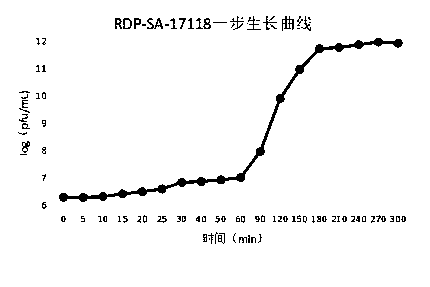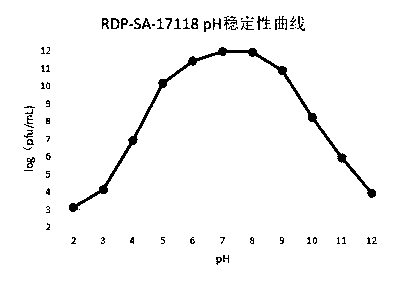Separation and application of high-lysis-rate salmonella phage RDP-SA-17118
A technology of RDP-SA-17118 and RDP-EC-16029, applied in the field of separation and application of Salmonella phage RDP-SA-17118 with high lysis rate, can solve the problems of drug failure and lack of antibiotics, and achieve good acid-base tolerance sexual effect
- Summary
- Abstract
- Description
- Claims
- Application Information
AI Technical Summary
Problems solved by technology
Method used
Image
Examples
Embodiment 1
[0037] Example 1 Isolation and Identification of Pathogenic Salmonella Avian S6
[0038] Sampling from diseased farms, aseptically take livers of diseased poultry, streaked on selective medium (SS agar), cultured at 37°C for 18-24 hours, and formed round, flat, neat edges and smooth surface on the medium Wet red colonies, pick typical colonies and continue to streak and purify 3 times, then pick a single colony and inoculate in 5mL LB broth, shake and culture at 200rpm at 37°C for 8h to obtain a uniform turbid bacterial suspension. Through 16sRNA molecular identification and serotype identification, it was determined to be pathogenic Salmonella, named S6, and stored in a -80°C refrigerator.
Embodiment 2
[0039] Example 2 Isolation and identification of phage RDP-SA-17118:
[0040](1) Manure treatment: Weigh 5g of chicken manure and add it to 10mL of sterile water to soak overnight, then centrifuge the overnight leaching solution at 10,000rpm for 5min, take the supernatant and pass it through a 0.22μm filter, and use the filtrate for later use;
[0041] (2) Preparation of mixed bacterial suspension: Take 0.2mL of bacterial suspension and 0.1mL of filtrate into 5mL of LB broth, culture at 37°C, shake at 200rpm overnight, then centrifuge at 10,000rpm for 5min, and pass the supernatant through a 0.22μm filter. Reserve the filtrate;
[0042] (3) Separation of phages: Separation of phages was carried out using the double-plate method. After mixing 0.1mL of the filtrate of the mixed bacterial suspension and 0.2mL of the host Salmonella suspension, they were bathed in water at 37°C for 10 minutes, and then double-plates were spread and placed in a 37°C oven. After culturing in an inc...
Embodiment 3
[0045] Example 3 Electron Microscopic Observation of Phage
[0046] Take 20 μL of the liquid containing crude phage particles and drop it on the copper grid, let it settle naturally for 15 min, absorb the excess liquid from the side with filter paper, add a drop of 2% phosphotungstic acid (PTA) on the copper grid to stain the phage for 10 min, and then Use filter paper to absorb the staining solution from the side, and observe the phage morphology with an electron microscope after the sample is dry, as shown in figure 1 shown.
[0047] The bacteriophage RDP-SA-17118 has a polyhedral three-dimensional symmetrical head wrapped around nucleic acid, with a diameter of about 70nm, a tail about 120nm in length, a tail sheath, and a neck connecting the head and tail. According to the Ninth Report of the International Virus Taxonomy Organization Virus Classification, the bacteriophage is classified as Myoviridae of the order Cauviridae.
[0048] Whole-genome sequencing and analysis ...
PUM
| Property | Measurement | Unit |
|---|---|---|
| diameter | aaaaa | aaaaa |
Abstract
Description
Claims
Application Information
 Login to View More
Login to View More - R&D
- Intellectual Property
- Life Sciences
- Materials
- Tech Scout
- Unparalleled Data Quality
- Higher Quality Content
- 60% Fewer Hallucinations
Browse by: Latest US Patents, China's latest patents, Technical Efficacy Thesaurus, Application Domain, Technology Topic, Popular Technical Reports.
© 2025 PatSnap. All rights reserved.Legal|Privacy policy|Modern Slavery Act Transparency Statement|Sitemap|About US| Contact US: help@patsnap.com



